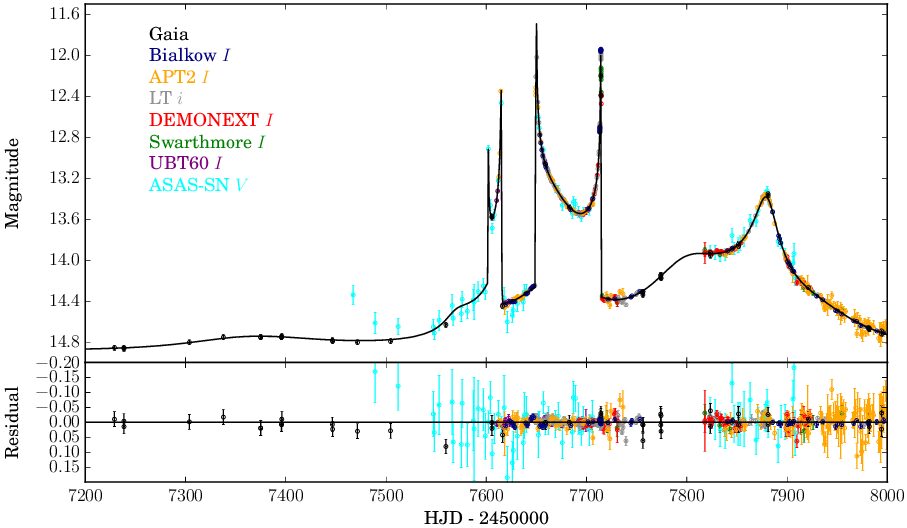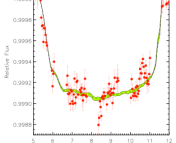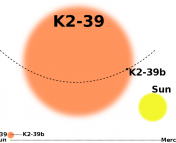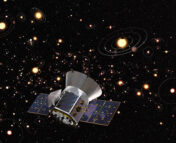Title: Microarcsecond Astrometry: Science Highlights from Gaia
Authors: Anthony G. A. Brown
First Author’s Institution: Leiden Observatory, Leiden University
Status: Published in Annual Review of Astronomy and Astrophysics [open access]
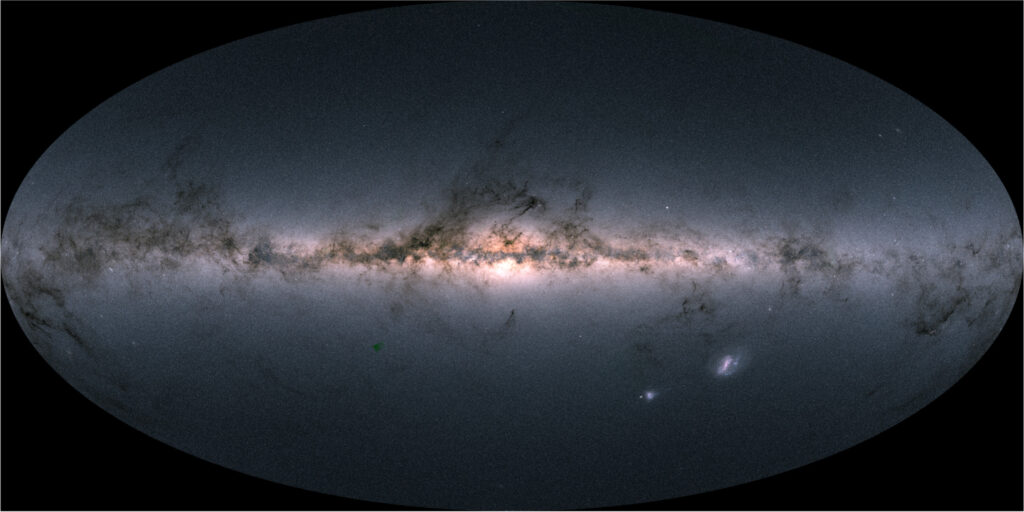
The European Space Agency’s space mission Gaia, launched in 2013, has proved indispensable for all subfields in astronomy. From studying nearby solar system objects, to quasars and galaxies, Gaia proves to be the tool that does all. With the release of Gaia DR3 just around the corner, astronomers are (im)patiently anticipating new content that will not only improve on current astrometric measurements, but will yield unparalleled numbers of spectra, radial velocities, abundances, and more. This article briefly summarizes science results enabled by Gaia DR1 & DR2 thus far, with a specific focus on solar system and stellar astronomy.
Gaia is an astrometry mission, meaning that it collects accurate positions, parallaxes, and proper motions for all sources to magnitude 20.7 in G band, and provides multi-color photometry and radial velocities for stars brighter than G ~ 17 mag. Gaia delivers incredible precision on its measurements. Positions for 1.1 billion sources are available up to G ~ 20, and parallaxes and proper motions are available for 2 million sources with sub-milliarcsecond (mas) precision. To put this into context, the angular diameter of Proxima Centauri – the closest star to the Sun – is 1 mas, which is also approximately the size of an astronaut on the surface of the moon, or the head of a pin on Earth as seen from the International Space Station. Finally, Gaia has also provided radial velocity for 7 million sources (out to G ~ 12), light curves for 550 000 variable stars, and astrophysical parameters (ie. effective temperature, radius, extinction) for ~160 million sources. Gaia truly is the one-stop shop for all your astrometric needs.
Solar System
Solar system science benefited tremendously from Gaia. Gaia DR2 provides astrometry and G-band photometry for ~14 000 solar system objects with high precision. Combining its astrometry and spectrophotometric data enables high-precision studies of solar system objects. In the context of the solar system, the major impact of Gaia has been the availability of all sky maps of star positions, parallaxes and proper motions, which allows astronomers to study occultations of stars by solar system objects. Orbit predictions even over a short period of time have increased the reliability of hazard predictions for near-Earth objects. For instance, using Gaia DR2 stellar positions and past occultation campaigns, Pluto’s shadow trajectory on Earth in 2016 was well predicted, and its atmospheric pressure was well studied. In general, Gaia DR2 astrometry enables much more precise predictions of stellar occultations by Kuiper Belt objects which in turn motivates astronomers to organize large-scale observation campaigns.
Exoplanets
While it has been predicted that by the end of its mission Gaia could increase the number of known exoplanets by a factor of three (21000 +/-6000, Perryman et al. 2014), it is already making significant contributions to the characterization of known planets and their host stars. However, characterization of exoplanets requires precise knowledge of properties of its host star, motivating the popular saying ‘Know Thy Star, Know Thy Planet’. NASA’s Kepler mission observed a patch of the sky for ~4 years and discovered thousands of exoplanets. Thanks to Gaia, there have been multiple efforts to derive fundamental stellar parameters of stars in the Kepler field. Since precise stellar radii and masses can be calculated to ~5-10 % errors, precise stellar parameters enable astronomers to investigate exoplanet demographics as a function of stellar age, abundance, and evolutionary state, while also potentially probing their formation history. Gaia is truly bringing other worlds closer to home.
Observational HR Diagrams

Gaia’s precise measurements of stellar positions & parallaxes enable us to study stellar populations. Tools like an Hertzprung-Russell (HR) diagram allow us to study the various stages of stellar evolution. Many studies have provided HR diagrams of various populations, such as the Orion region (Figure 5 in the paper) or the Kepler field of view (Figure 8 in Berger et al. 2020), that have revealed interesting substructures. Incredible insights into processes in the stellar interior have been made possible by a basic tool such as an HR diagram of Gaia data. For instance, Jao & Feiden 2020 found a gap in their HR diagram of Gaia stars that they attribute to non-equilibrium fusion in the stellar core, and mixing between the core and the envelope.
Similarly, Gaia has enabled many studies of moving groups and cluster characterization. One example is the discovery of a young stellar population found in the Scorpio-Centaurus-Lupus-Sky region via a simple selection on parallax and cuts in an HR diagram (Figure 1 in Villa Velez+2018). Gaia also enabled the construction of a large all-sky sample of white dwarfs. In fact, an observational HR diagram in Gaia DR2 release revealed bifurcation of the white dwarf sequence attributed to varying compositions of white dwarfs (Figure 13 in this paper).
Galactic Archaeology
Lastly, Galactic Archaeology was one of the many subfields that was revolutionized by Gaia. Helmi et al. 2020 provides a wonderful introduction of the field, as well as progress facilitated by Gaia DR2. A major discovery made possible by Gaia was that a large fraction of the halo stars near the Sun were debris stars from Gaia-Enceladus (or Gaia sausage), the last big merger event experienced by the Milky Way. Furthermore, Gaia’s velocity and positions of stars in three dimensions revealed that the Milky Way is in fact not in equilibrium. Our Galaxy was recently disturbed by an intruder – most likely the Sagittarius dwarf – that produced waves in the Galactic plane. Without precise information on stellar velocity and positions, this detail into our galaxy’s history would not have been possible.
Other substructures in the Milky Way have also been better characterized by Gaia, such as stellar streams. Pre-Gaia, such streams were a faint overdensity of stars stretched out in position that were hard to disentangle or even see against the stars in front of and behind them. However, with Gaia measurements, we can filter out foreground stars based on their large parallaxes and/or proper motions, to isolate a stellar stream and even probe clumpy dark matter distributions. There are still more exciting discoveries to be made in Galactic archaeology and beyond; in fact, the era of Galactic Seismology – exploring the response of the Galaxy to internal and external perturbations – has just begun.
Looking Ahead
June 13th, 2022 is a date circled in many astronomers’ calendars. With unwavering excitement and trepidation, astronomers across subfields will finally have access to new Gaia data. Multiple cities, such as Chicago, NYC, and Aarhus, are also planning week-long Gaia sprints which involve exploring and playing with the new data with like-minded astronomers in similar research areas. Gaia DR3 promises to improve measurements on previous sources, but also provide new content. The full list of the data products are listed on Gaia’s webpage, but some exciting products include spectra from Radial Velocity Spectrograph (with resolution of ~11 500), catalog of binary stars, astrometry for 100 000 solar system objects, reflectance spectra of ~5000 asteroids, chemical abundances for ~2.5 million stars, and much, much, much more. The collective excitement over a new data release is inspiring, yet humbling, and like its predecessor, Gaia DR3 will advance our knowledge of the Universe on all scales, across the sky.
Edited by: Jessie Thwaites
Featured image credit: ESA C. Carreau

